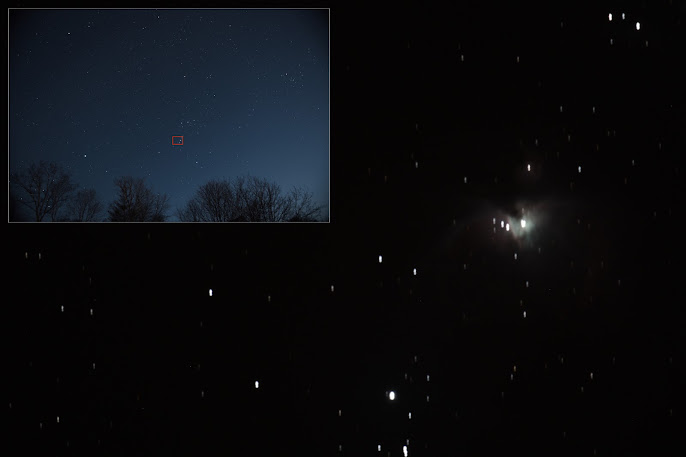A Failed Astrophotography Session
Steve here. I was so happy to find that M42, the Orion Nebula, was just visible in my astro time-lapse of Orion that I decided to try to push this setup to the limit and shoot the nebula with the 800mm lens we use for birding.
Compared to the zoom lens at 18mm that I used for the time-lapse, this lens offers 44x magnification. That would enlarge the pencil-point-sized nebula in the time-lapse image to something the size of a fingertip.
The result is above (this is the full uncropped and unprocessed frame showing the three "stars" of Orion's sword hanging down from his belt; the middle "star" of the sword is actually the nebula). The inset is a full image from the time-lapse; the red box shows the region of interest, giving an idea of the optical magnification
While it shows the nebula, the image is poor. The focus is off, and there appears to be some vibration in the photos. This was the best of the bunch. This is a 118-sec exposure at f/11, ISO 400.
The problem is that this lens also magnifies any problems, literally and figuratively. The main issue is the weight. As you can see below, the lens is large and bulky. The tracking mount can handle it, but the small added ball head isn't really stiff enough for it.
I think that's the source of the vibration. One possible solution might be to eliminate the ball head and mount more directly to the tracking mount. Or use a beefier ball head.
The bulk also makes things hard to manage, at the same time as the much narrower field of view makes finding and lining up on the target more difficult. I need to loosen the ball enough to aim the camera, then tighten it back up once on target.
That also made focusing awkward. I thought I had it in focus, but apparently I was a little off. Or I jostled it out of focus managing things. I should have made a final pass focusing after aiming. But that also requires delicate handling not to knock the lens out of position. It's a bit of a juggling act.
Mistakes are learning opportunities. The big lesson here is to leave focus for last. Just get a good starting focus so you can find your target, get everything set, then refocus very carefully.
I'll try again without the ball head, but this may have exceeded what this rig is capable of for narrow-field imaging. It's much more convenient for wide-field.
I'll also try using my 55-210mm zoom at the 210 setting. That should be a reasonable compromise for narrower field imaging with this setup. It'll only give an image of the nebula a quarter the size of this one, but if that allows me to get a better quality image, I might have something good enough to blow up digitally and crop.




Comments
Post a Comment